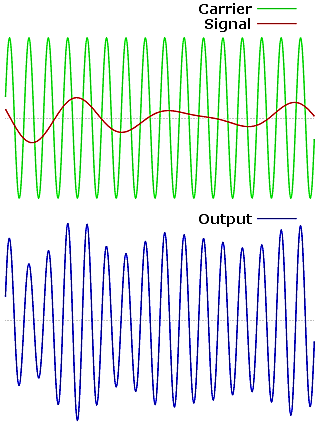
For an AM-system the total power of modulated signal is 600W and that of carrier is 400W, the modulation index is
(A) 0.25
(B) 0.36
(C) 0.54
(D) 1
Answer
142.2k+ views
Hint The modulation index for the total power of the modulated signal and carrier signal is related to total power and carrier power is given by ${P_T} = {P_C}\left( {1 + \dfrac{{{m_a}^2}}{2}} \right)$ . Substitute the power values and simplify to get the modulation index.
Complete step-by-step answer
The process of changing the amplitude of a carrier wave in accordance with the amplitude of the audio frequency signal is known as amplitude modulation (AM).

Power modulation index is given by,
${P_T} = {P_C}\left( {1 + \dfrac{{{m_a}^2}}{2}} \right)$
Where, ${P_T}$ is the total power modulated, ${P_C}$ is the carrier power, and ${m_a}$ is the modulation index.
It is given in the question that,
Total power of modulated signal$ = 600W$
Carrier power$ = 400W$
Substitute the given data in the above expression.
$600 = 400\left( {1 + \dfrac{{m_a^2}}{2}} \right)$
$\dfrac{3}{2} = 1 + \dfrac{{m_a^2}}{2}$
$\dfrac{{m_a^2}}{2} = \dfrac{1}{2}$
${m_a} = 1$
Hence, the modulation index is 1 and the correct option is D.
Note Maximum power in the AM without distortion will occur when ${m_a} = 1$
If ${I_C}$is unmodulated current and${I_T}$ is total modulated current then,
$\dfrac{{{P_T}}}{{{P_C}}} = {\left( {\dfrac{{{I_T}}}{{{I_C}}}} \right)^2}$
The ratio of change of amplitude of carrier wave to the amplitude of original carrier wave is called modulation factor or degree of modulation to modulation index. It is also called modulation depth.
Complete step-by-step answer
The process of changing the amplitude of a carrier wave in accordance with the amplitude of the audio frequency signal is known as amplitude modulation (AM).

Power modulation index is given by,
${P_T} = {P_C}\left( {1 + \dfrac{{{m_a}^2}}{2}} \right)$
Where, ${P_T}$ is the total power modulated, ${P_C}$ is the carrier power, and ${m_a}$ is the modulation index.
It is given in the question that,
Total power of modulated signal$ = 600W$
Carrier power$ = 400W$
Substitute the given data in the above expression.
$600 = 400\left( {1 + \dfrac{{m_a^2}}{2}} \right)$
$\dfrac{3}{2} = 1 + \dfrac{{m_a^2}}{2}$
$\dfrac{{m_a^2}}{2} = \dfrac{1}{2}$
${m_a} = 1$
Hence, the modulation index is 1 and the correct option is D.
Note Maximum power in the AM without distortion will occur when ${m_a} = 1$
If ${I_C}$is unmodulated current and${I_T}$ is total modulated current then,
$\dfrac{{{P_T}}}{{{P_C}}} = {\left( {\dfrac{{{I_T}}}{{{I_C}}}} \right)^2}$
The ratio of change of amplitude of carrier wave to the amplitude of original carrier wave is called modulation factor or degree of modulation to modulation index. It is also called modulation depth.
Recently Updated Pages
Uniform Acceleration - Definition, Equation, Examples, and FAQs

Difference Between Mass and Weight

Difference Between Circuit Switching and Packet Switching

JEE Main Participating Colleges 2024 - A Complete List of Top Colleges

JEE Main Maths Paper Pattern 2025 – Marking, Sections & Tips

Sign up for JEE Main 2025 Live Classes - Vedantu

Trending doubts
JEE Main 2025 Session 2: Application Form (Out), Exam Dates (Released), Eligibility, & More

JEE Main Exam Marking Scheme: Detailed Breakdown of Marks and Negative Marking

JEE Main 2025: Derivation of Equation of Trajectory in Physics

Electric Field Due to Uniformly Charged Ring for JEE Main 2025 - Formula and Derivation

Learn About Angle Of Deviation In Prism: JEE Main Physics 2025

Degree of Dissociation and Its Formula With Solved Example for JEE

Other Pages
Units and Measurements Class 11 Notes: CBSE Physics Chapter 1

JEE Advanced Marks vs Ranks 2025: Understanding Category-wise Qualifying Marks and Previous Year Cut-offs

NCERT Solutions for Class 11 Physics Chapter 1 Units and Measurements

JEE Advanced 2025: Dates, Registration, Syllabus, Eligibility Criteria and More

Motion in a Straight Line Class 11 Notes: CBSE Physics Chapter 2

JEE Advanced Weightage 2025 Chapter-Wise for Physics, Maths and Chemistry




